Cloche Encounters
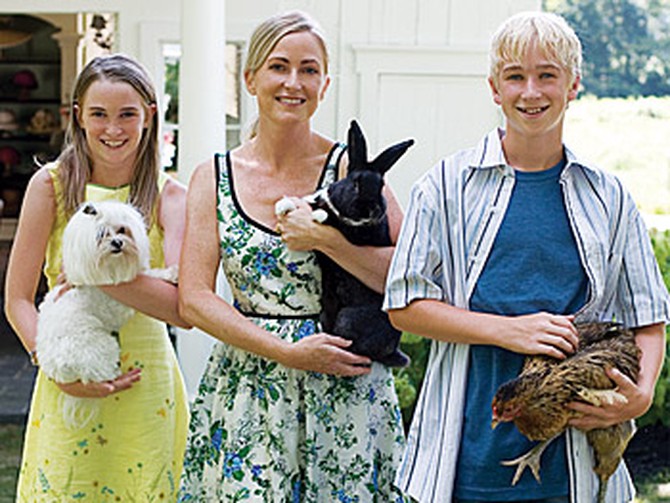
Credits: Photographs by Björn Wallander, styling by Rebecca Omweg
Amy Hamilton's Granville Millinery Company is headquartered in a converted barn beside the 1859 home she shares with her husband, artist Paul Hamilton, and their children, Marcus, 14, and Lillie, 12.
When Amy and Paul first met, at the Columbus College of Art & Design in 1988, they discovered they shared the dream of finding a home with a barn that could be used as an art studio. Almost nine years ago, they bought a six-acre farm outside the college town of Granville, Ohio. They rescued the house, a dilapidated cottage that didn't even have running water until 1985, before turning their attention to the outbuildings.
When Amy and Paul first met, at the Columbus College of Art & Design in 1988, they discovered they shared the dream of finding a home with a barn that could be used as an art studio. Almost nine years ago, they bought a six-acre farm outside the college town of Granville, Ohio. They rescued the house, a dilapidated cottage that didn't even have running water until 1985, before turning their attention to the outbuildings.
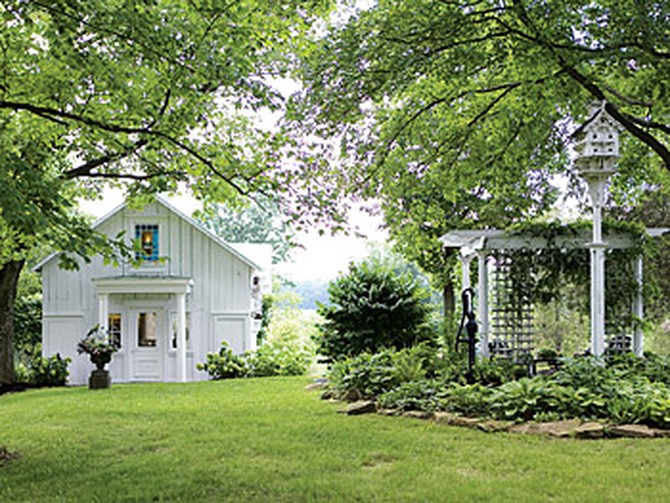
Credits: Photographs by Björn Wallander, styling by Rebecca Omweg
Paul rebuilt the farm's main barn, with its high ceilings and massive timbers, turning it into a studio where he could paint. Then he tackled the smaller horse barn, converting it into a place for Amy to design, craft, and display her work.
Paul also constructed the birdhouse and pergola. The pump, which was the home's primary water source until 1985, is now used for Amy's plants.
Paul also constructed the birdhouse and pergola. The pump, which was the home's primary water source until 1985, is now used for Amy's plants.
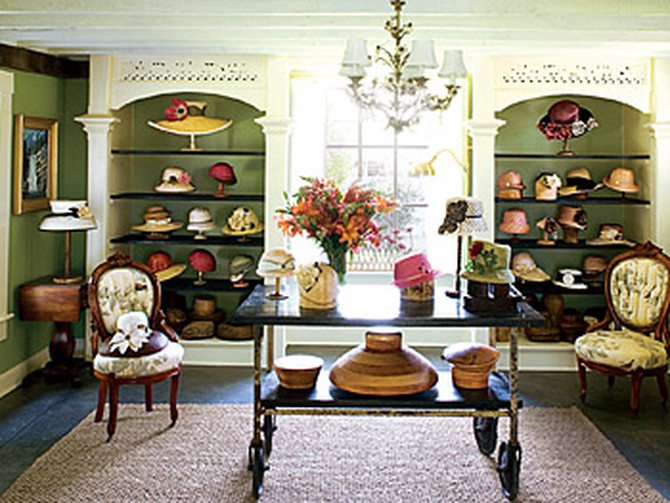
Credits: Photographs by Björn Wallander, styling by Rebecca Omweg
Amy Hamilton displays her feminine, 1940s-style hat designs in her studio. "I wanted it to feel like a boutique," she says. She got her wish. If the family's ducks, Huey, Louie and Dewey, weren't constantly quacking outside her window, Amy could very easily picture herself in a 19th-century atelier. The studio's windowsills are deep enough to hold hat stands, and built-in display cabinets flank the rear window. Overhead, an ornate chandelier hangs down through the opening to the hayloft, the only hint of the barn's original purpose.
A broad table holds a colorful collection of antique wooden hat blocks. "I try to work with classic shapes, but with a fresh approach," Amy says. And against one wall, she's stuffed scores of cubbyholes with hundreds of yards of ribbon and lined up dozens of jars filled with bright beads and buttons.
A broad table holds a colorful collection of antique wooden hat blocks. "I try to work with classic shapes, but with a fresh approach," Amy says. And against one wall, she's stuffed scores of cubbyholes with hundreds of yards of ribbon and lined up dozens of jars filled with bright beads and buttons.
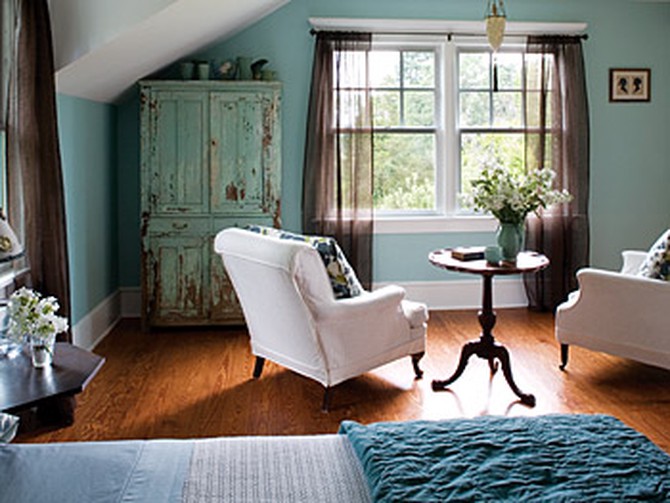
Credits: Photographs by Björn Wallander, styling by Rebecca Omweg
In her home, as in her work, Amy chooses classic forms and materials and then uses them inventively. An open kitchen cupboard is filled with ironstone china, the unembellished white pottery found in nearly every American country pantry in the mid-19th century. Displayed against blue walls, the humble plates, bowls and pitchers seem to take on the pedigree of Wedgwood. The master bath, which is tucked under the eaves on the second floor of the low-slung home, looks at once rural, rustic, contemporary, and opulent: The room (a recent addition) has a marble floor and a stainless-steel shower, and the tub surround is made of old-fashioned wooden bead board but topped with a ledge of polished concrete.
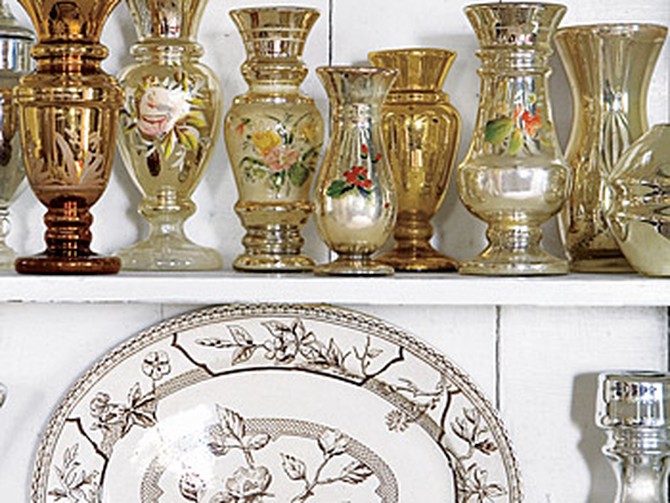
Credits: Photographs by Björn Wallander, styling by Rebecca Omweg
It's evident that this is a home of artists, with paintings and personal treasures around every corner. Tucked under the glass top of Amy's desk are sketches by her children. One wall of the living room is covered with landscapes—pictures of their home as well as the weathered barns, quiet woods and snow-covered fields around Granville. The work is by Paul. "He gave them to the kids and me one year for Christmas," Amy says.
The early-20th-century mercury glass in the living room was a gift from Amy's mother, who found the vases in New England shops and yard sales. Amy collects 19th-century brown-and-white transferware, displayed on the shelf below.
Through the windows in the master bedroom, one can see the black pump that used to be the home's only water supply; once merely utilitarian, it's now the centerpiece of a still life, perfectly positioned between two maples. And from the kitchen, there's a view of the pond. After dinner, it would be hard to resist settling into one of the plump chairs that offer front-row seats as the sunset turns the water's surface into a looking glass.
"I try to make my home and my work creative, and peaceful," she says, certain she's found the place to do just that.
The early-20th-century mercury glass in the living room was a gift from Amy's mother, who found the vases in New England shops and yard sales. Amy collects 19th-century brown-and-white transferware, displayed on the shelf below.
Through the windows in the master bedroom, one can see the black pump that used to be the home's only water supply; once merely utilitarian, it's now the centerpiece of a still life, perfectly positioned between two maples. And from the kitchen, there's a view of the pond. After dinner, it would be hard to resist settling into one of the plump chairs that offer front-row seats as the sunset turns the water's surface into a looking glass.
"I try to make my home and my work creative, and peaceful," she says, certain she's found the place to do just that.

Credits: Photographs by Björn Wallander, styling by Rebecca Omweg
For Amy Hamilton, quality is...
A home studio. "Because we're blessed to be able to work at home, my husband and I can greet our children when they hop off the bus from school each day."
Fields of fireflies. "It was our dream to raise our children in the country so that they could experience nature."
Art. "The majority of our time is spent creating art, whether it's Paul's painting or my millinery. We pour our energy into what we do, and it surrounds us in our home and in our studios."
Inspiration out the window. "On our property, there's a constant supply of inspiration that the whole family takes advantage of. I clip blooms from the garden and then recreate them in silk for my hats. Paul has painted images of the water lilies on the pond and the structures on our property many times. Marcus creates rafts from fallen branches to float on the pond. Lillie took a walk in the woods the other day and came back inspired to write a poem."
For more information on Amy's hats, visit granvillemillinerycompany.com.
A home studio. "Because we're blessed to be able to work at home, my husband and I can greet our children when they hop off the bus from school each day."
Fields of fireflies. "It was our dream to raise our children in the country so that they could experience nature."
Art. "The majority of our time is spent creating art, whether it's Paul's painting or my millinery. We pour our energy into what we do, and it surrounds us in our home and in our studios."
Inspiration out the window. "On our property, there's a constant supply of inspiration that the whole family takes advantage of. I clip blooms from the garden and then recreate them in silk for my hats. Paul has painted images of the water lilies on the pond and the structures on our property many times. Marcus creates rafts from fallen branches to float on the pond. Lillie took a walk in the woods the other day and came back inspired to write a poem."
For more information on Amy's hats, visit granvillemillinerycompany.com.
From the Summer 2007 issue of O, The Oprah Magazine

